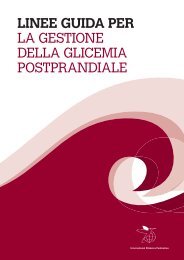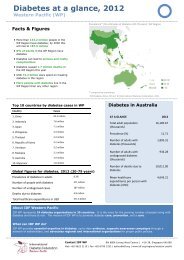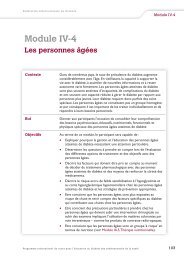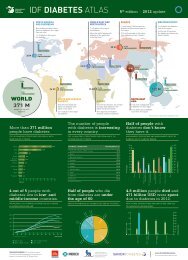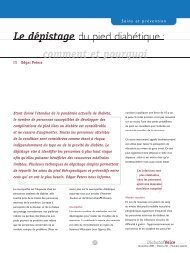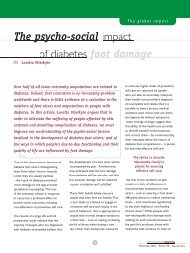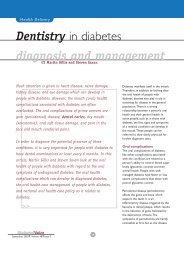Global guideline on pregnancy and diabetes - International ...
Global guideline on pregnancy and diabetes - International ...
Global guideline on pregnancy and diabetes - International ...
Create successful ePaper yourself
Turn your PDF publications into a flip-book with our unique Google optimized e-Paper software.
<str<strong>on</strong>g>Global</str<strong>on</strong>g> Guideline <strong>on</strong> Pregnancy <strong>and</strong> Diabetes<br />
4.3.4 Oral glucose-lowering agents in <strong>pregnancy</strong><br />
4.3.4.1 General c<strong>on</strong>siderati<strong>on</strong>s<br />
The majority of women diagnosed with GDM can be<br />
managed by modificati<strong>on</strong> of lifestyle (including patterns<br />
of eating <strong>and</strong> of physical activity). However, women who<br />
exceed predetermined glycaemic goals have been generally<br />
advised to commence <strong>on</strong> insulin. Insulin is expensive,<br />
relatively difficult to administer, <strong>and</strong> also difficult to store<br />
if the circumstances are less than optimal. In recent years<br />
two clinical trials have examined the effects of the use<br />
during <strong>pregnancy</strong> of glyburide (glibenclamide) [93] <strong>and</strong><br />
metformin [94]. These studies have stimulated the debate<br />
about the use of oral glucose-lowering agents for the<br />
treatment of women with GDM.<br />
Glucose profiles in women with GDM will show a basal<br />
level <strong>and</strong> postpr<strong>and</strong>ial spikes. When c<strong>on</strong>sidering the glucose<br />
crossing from the mother to the fetus, there is a basal<br />
c<strong>on</strong>sistent amount <strong>and</strong> the spikes associated with food<br />
intake. On a theoretical level, in the process of transfer<br />
of the higher postpr<strong>and</strong>ial glucose levels, the fetus will<br />
tend to recirculate the higher glucose via amniotic fluid<br />
reuptake, thus producing a more profound <strong>and</strong> prol<strong>on</strong>ged<br />
effect than the simpler rise <strong>and</strong> fall of glucose seen in the<br />
mother [95]. Thus agents that lower the maternal basal<br />
glucose level may not have as great an effect <strong>on</strong> the fetus<br />
as agents that lower the maternal postpr<strong>and</strong>ial glucose<br />
levels. This c<strong>on</strong>cept should be kept in mind when therapeutic<br />
choices are being c<strong>on</strong>sidered.<br />
4.3.4.2 Metformin<br />
There has been extensive clinical experience with the<br />
use of metformin in <strong>pregnancy</strong> over more than a quarter<br />
of a century [96,97]. Metformin does cross the placenta,<br />
but there appear to have been no teratogenic problems,<br />
although this questi<strong>on</strong> has not been systematically examined.<br />
The recent Metformin in Gestati<strong>on</strong>al Diabetes (MiG)<br />
study [94] has shown that metformin can be a viable<br />
alternative to insulin in a proporti<strong>on</strong> of cases. Both NICE<br />
<strong>and</strong> CDA include metformin as an opti<strong>on</strong> for treatment<br />
of GDM, <strong>and</strong> NICE also includes metformin as an opti<strong>on</strong><br />
for the treatment of type 2 <strong>diabetes</strong> in <strong>pregnancy</strong>, with the<br />
proviso that it is not licensed for these indicati<strong>on</strong>s [2,3].<br />
4.3.4.3 Sulf<strong>on</strong>ylureas<br />
Not all sulf<strong>on</strong>ylureas cross the placenta, <strong>and</strong> the use of<br />
glibenclamide (glyburide) to treat women with GDM was<br />
examined prospectively by Langer [93] <strong>and</strong> has subsequently<br />
been the subject of several retrospective reports,<br />
as recently reviewed [98]. As with metformin, glibenclamide<br />
(glyburide) appears to be an alternative to insulin in some<br />
instances, although dose titrati<strong>on</strong> can mean that women<br />
may be without optimal treatment for some weeks. Both<br />
NICE <strong>and</strong> CDA include glibenclamide (glyburide) as an<br />
opti<strong>on</strong> for treatment of GDM (although it is not licensed<br />
for this indicati<strong>on</strong>) [2,3]. However, despite these positives,<br />
for women with type 2 <strong>diabetes</strong> there have been some<br />
reports of adverse outcomes associated with the use of<br />
glibenclamide (glyburide) in the third trimester [97,99].<br />
14<br />
Pregnancy_EN2.indd 14 16/09/09 15:42





